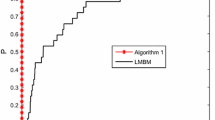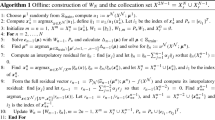Abstract
Reduced-space inexact-Newton–Krylov (RSNK) algorithms provide a modular and scalable framework for solving differential-equation-constrained optimization problems; thus, this class of algorithms provides an attractive compromise between poorly scaling “black-box” methods and more intrusive, full-space optimization algorithms. One of the challenges of implementing RSNK methods is the efficient solution of the linear subproblems, which involve the reduced Hessian. This paper explores inexact Hessian-vector products to improve the efficiency of these subproblems. The reduced-Hessian-vector products, which are required by the Krylov solver in RSNK, can be determined by solving two second-order adjoint equations. To reduce computational cost, we consider the approximate (i.e. inexact) solution of the second-order adjoints. We present bounds for the second-order adjoint tolerances that ensure the Hessian-vector product remains sufficiently accurate for inexact-Krylov methods. The bounds involve the 2-norm of the state and first-order adjoint sensitivities, and we provide an inexpensive Lanczos algorithm to estimate these matrix norms. Using numerical experiments, we investigate the proposed RSNK algorithm and compare it to other optimization algorithms.







Similar content being viewed by others
Notes
More precisely, they simplified the objective function in order to simplify the Hessian.
In the context of DE-constrained optimization, the Lagrange multipliers are typically called the adjoint variables, and this is the convention adopted here.
Again, we drop the Newton subscript \(k\).
Both reduced-space algorithms exhibit a drop in cost at 60 design variables: we have no explanation for this behaviour at this time.
References
Akçelik V, Biros G, Ghattas O (2002) Parallel multiscale Gauss–Newton–Krylov methods for inverse wave propagation. SC Conference, p. 41 doi:10.1109/SC.2002.10002
Akçelik V, Biros G, Ghattas O, Hill J, Keyes D, van Bloemen Waanders B (2006) Parallel algorithms for PDE-constrained optimization. In: Heroux MA, Raghavan P, Simon HD (eds) Parallel processing for scientific computing, chap. 16. Society for Industrial and Applied Mathematics, pp 291–322. doi:10.1137/1.9780898718133.ch16
Anderson JD (1991) Fundamentals of aerodynamics, 2nd edn. McGraw-Hill Inc., New York
Arnold DN, Brezzi F, Cockburn B, Marini LD (2002) Unified analysis of discontinuous Galerkin methods for elliptic problems. SIAM J Numer Anal 39(5):1749–1779. doi:10.1137/s0036142901384162
Biros G, Ghattas O (2005) Parallel Lagrange–Newton–Krylov–Schur methods for PDE-constrained optimization. Part I: The Krylov–Schur solver. SIAM J Sci Comput 27:687–713
Biros G, Ghattas O (2005) Parallel Lagrange–Newton–Krylov–Schur methods for PDE-constrained optimization. Part II: The Lagrange–Newton solver and its application to optimal control of steady viscous flows. SIAM J Sci Comput 27:714–739
Borzì A, Schulz V (2011) Computational optimization of systems governed by partial differential equations. Society for Industrial and Applied Mathematics, pp. 47–48 doi:10.1137/1.9781611972054
Borzì A, Schulz V (2011) Computational optimization of systems governed by partial differential equations. Society for Industrial and Applied Mathematics, pp 62–66. doi:10.1137/1.9781611972054
Bouras A, Frayssé V (2005) Inexact matrix-vector products in Krylov methods for solving linear systems: a relaxation strategy. SIAM J Matrix Anal Appl 26(3):660–678. doi:10.1137/s0895479801384743
Braack M (2009) Optimal control in fluid mechanics by finite elements with symmetric stabilization. SIAM J Control Optim 48(2):672–687. doi:10.1137/060653494
Byrd RH, Curtis FE, Nocedal J (2008) An inexact SQP method for equality constrained optimization. SIAM J Optim 19(1):351–369. doi:10.1137/060674004
Byrd RH, Curtis FE, Nocedal J (2010) An inexact Newton method for nonconvex equality constrained optimization. Math Program 122(2):273–299. doi:10.1007/s10107-008-0248-3
Carpenter MH, Gottlieb D, Abarbanel S (1994) Time-stable boundary conditions for finite-difference schemes solving hyperbolic systems: methodology and application to high-order compact schemes. J Comput Phys 111(2):220–236. doi:10.1006/jcph.1994.1057
Conn AR, Gould NIM, Toint PL (2000) Trust region methods. Society for Industrial and Applied Mathematics doi:10.1137/1.9780898719857
Dembo RS, Eisenstat SC, Steihaug T (1982) Inexact Newton methods. SIAM J Numer Anal 19(2):400–408. doi:10.1137/0719025
Du X, Sarkis M, Schaerer CE, Szyld DB (2013) Inexact and truncated parareal-in-time Krylov subspace methods for parabolic optimal control problems. Electron Trans Numer Anal 40:36–57
Farin GE (1997) Curves and surfaces for computed aided geometric design: a practical guide, 4th edn. Academic Press, Inc, London
Feng D, Pulliam TH (1995) An all-at-once reduced hessian SQP scheme for aerodynamic design optimization. Tech. Rep. RIACS-TR-95.19, NASA Ames Research Center, Moffett Field, California
Fletcher R (2000) Practical methods of optimization, 2nd edn. A Wiley-Interscience Publication, Wiley, New York
Frank PD, Shubin GR (1992) A comparison of optimization-based approaches for a model computational aerodynamics design problem. J Comput Phys 98(1):74–89
Funaro D, Gottlieb D (1988) A new method of imposing boundary conditions in pseudospectral approximations of hyperbolic equations. Math Comput 51(184):599–613
Gatsis J, Zingg DW (2003) A fully-coupled Newton–Krylov algorithm for aerodynamic optimization. In: 16th AIAA Computational Fluid Dynamics Conference, AIAA-2003-3956. Orlando.
Ghate D, Giles M (2007) Efficient Hessian calculation using automatic differentiation. In: 25th AIAA Applied Aerodynamics Conference, AIAA-2007-4059. Miami. doi:10.2514/6.2007-4059
Golub GH, Ye Q (1999) Inexact preconditioned conjugate gradient method with inner–outer iteration. SIAM J Sci Comput 21(4):1305–1320. doi:10.1137/s1064827597323415
Griewank A, Walther A (2008) Evaluating derivatives: principles and techniques of algorithmic differentiation. Society for Industrial and Applied Mathematics http://www.worldcat.org/isbn/9780898716597
Griewank A, Walther A (2008) Evaluating derivatives: principles and techniques of algorithmic differentiation, chap. 5. Society for Industrial and Applied Mathematics, pp. 91–105. http://www.worldcat.org/isbn/9780898716597
Gunzburger MD (2003) Perspectives in flow control and optimization. Society for Industrial and Applied Mathematics http://www.worldcat.org/isbn/9780898715279
Haber E, Ascher UM (2001) Preconditioned all-at-once methods for large, sparse parameter estimation problems. Inverse Probl 17(6):1847–1864. doi:10.1088/0266-5611/17/6/319
Hartmann R (2007) Adjoint consistency analysis of discontinuous Galerkin discretizations. SIAM J Numer Anal 45(6):2671–2696. doi:10.1137/060665117
Heinkenschloss M, Vicente LN (1999) An interface optimization and application for the numerical solution of optimal control problems. ACM Trans Math Softw 25(2):157–190. doi:10.1145/317275.317278
Hicken JE, Alonso JJ (2013) Comparison of reduced- and full-space algorithms for PDE-constrained optimization. In: 51st AIAA aerospace sciences meeting, AIAA-2013-1043. Grapevine. doi:10.2514/6.2013-1043
Hicken JE, Zingg DW (2011) Superconvergent functional estimates from summation-by-parts finite-difference discretizations. SIAM J Sci Comput 33(2):893–922. doi:10.1137/100790987
Hicken JE, Zingg DW (2011) The role of dual consistency in functional accuracy: error estimation and superconvergence. In: 20th AIAA computational fluid dynamics conference, AIAA-2011-3855. Honolulu.
Hicken JE, Zingg DW (2012) Dual consistency and functional accuracy: a finite-difference perspective. J Comput Phys 256:161–182
Hinze M, Pinnau R, Ulbrich M, Ulbrich S (2009) Optimization with PDE constraints. Springer, New York, pp 64–65. http://www.worldcat.org/isbn/9781402088384
Iollo A, Salas MD, Ta’asan S (1993) Shape optimization governed by the Euler equations using an adjoint method. Tech. Rep. ICASE 93–78, NASA Langley Research Center, Hampton.
Keyes DE (1995) Aerodynamic applications of Newton–Krylov–Schwarz solvers. In: Proceedings of the 14th international conference on numerical methods in fluid dynamics. Springer, New York, pp 1–20
Knoll DA, Keyes DE (2004) Jacobian-free Newton–Krylov methods: a survey of approaches and applications. J Comput Phys 193(2):357–397. doi:10.1016/j.jcp.2003.08.010
Kreiss HO, Scherer G (1974) Finite element and finite difference methods for hyperbolic partial differential equations. In: de Boor C (ed) Mathematical aspects of finite elements in partial differential equations. Mathematics Research Center, the University of Wisconsin Academic Press, Madison
Lanczos C (1950) An iteration method for the solution of the eigenvalue problem of linear differential and integral operators. J Res Natl Bur Stand 45(4):255–282
Liu DC, Nocedal J (1989) On the limited memory BFGS method for large scale optimization. Math Program 45:503–528. doi:10.1007/BF01589116
Lu JC (2005) An a posteriori error control framework for adaptive precision optimization using discontinuous Galerkin finite element method. Ph.D. thesis, Massachusetts Institute of Technology, Cambridge
Martins JRRA, Sturdza P, Alonso JJ (2003) The complex-step derivative approximation. ACM Trans Math Softw 29(3):245–262. doi:10.1145/838250.838251
Mattsson K, Svärd M, Nordström J (2004) Stable and accurate artificial dissipation. J Sci Comput 21(1):57–79
Melvin RG, Huffman WP, Young DP, Johnson FT, Hilmes CL (1999) Recent progress in aerodynamic design optimization. Int J Numer Methods Fluids 30(2):205–206. doi:10.1002/(sici)1097-0363(19990530)30:2%3C205:aid-fld827%3E3.0.co;2-u
Morales JL, Nocedal J (2000) Automatic preconditioning by limited memory quasi-Newton updating. SIAM J Optim 10(4):1079–1096. doi:10.1137/S1052623497327854
Nocedal J, Wright SJ (2006) Numerical optimization, 2nd edn. Springer, Berlin
Nocedal J, Wright SJ (2006) Numerical optimization, chap. 6, 2nd edn. Springer, Berlin
Nocedal J, Wright SJ (2006) Numerical optimization, chap. 7, 2nd edn. Springer, Berlin
Nocedal J, Wright SJ (2006) Numerical optimization, chap. 12, 2nd edn. Springer, Berlin
Rumpfkeil MP, Mavriplis DJ (2010) Efficient Hessian calculations using automatic differentiation and the adjoint method with applications. AIAA J 48(10):2406–2417. doi:10.2514/1.j050451
Saad Y (1993) A flexible inner–outer preconditioned GMRES algorithm. SIAM J Sci Stat Comput 14(2):461–469
Saad Y (2003) Iterative methods for sparse linear systems, chap. 6, 2nd edn. SIAM, Philadelphia
Saad Y (2011) Numerical methods for Large eigenvalue problems. Society for Industrial and Applied Mathematics. doi:10.1137/1.9781611970739
Saad Y, Schultz MH (1986) GMRES: a generalized minimal residual algorithm for solving nonsymmetric linear systems. SIAM J Sci Stat Comput 7(3):856–869
Simoncini V, Szyld DB (2003) Theory of inexact Krylov subspace methods and applications to scientific computing. SIAM J Sci Comput 25(2):454–477. doi:10.1137/s1064827502406415
Squire W, Trapp G (1998) Using complex variables to estimate derivatives of real functions. SIAM Rev 40(1):110–112
Strand B (1994) Summation by parts for finite difference approximations for d/dx. J Comput Phys 110(1):47–67. doi:10.1006/jcph.1994.1005
Ta’asan S, Kuruvila G, Salas MD (1992) Aerodynamic design and optimization in one shot. In: The 30th AIAA aerospace sciences meeting and exhibit, AIAA-1992-25
Waltz RA, Nocedal J (2003), KNITRO user’s manual. Northwestern University, Evanston, Technical, Report OTC-2003/5
Wang Z, Navon IM, Dimet FX, Zou X (1992) The second order adjoint analysis: theory and applications. Meteorol Atmos Phys 50:3–20. doi:10.1007/BF01025501
van den Eshof J, Sleijpen GLG (2004) Inexact Krylov subspace methods for linear systems. SIAM J Matrix Anal Appl 26(1):125–153. doi:10.1137/s0895479802403459
Acknowledgments
The author thanks the anonymous referees for their careful reading of the manuscript and helpful remarks. The author gratefully acknowledges the financial support of Rensselaer Polytechnic Institute.
Author information
Authors and Affiliations
Corresponding author
Appendix: Optimization algorithms
Appendix: Optimization algorithms



Rights and permissions
About this article
Cite this article
Hicken, J.E. Inexact Hessian-vector products in reduced-space differential-equation constrained optimization. Optim Eng 15, 575–608 (2014). https://doi.org/10.1007/s11081-014-9258-6
Received:
Accepted:
Published:
Issue Date:
DOI: https://doi.org/10.1007/s11081-014-9258-6




